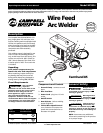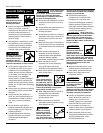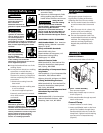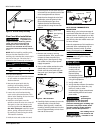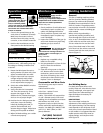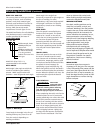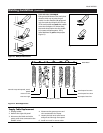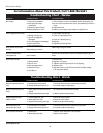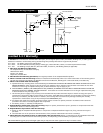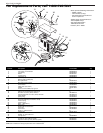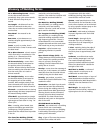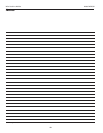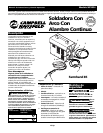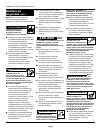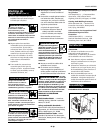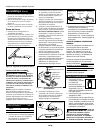
LOCATION
Selecting the proper location can
significantly increase performance,
reliability and life of the arc welder.
● For best results locate the welder in
an environment that is clean and
dry.
● Store flux core wire in a clean, dry
location with low humidity to
preserve the flux wire coating.
● The use of an extension cord is not
recommended for electric arc welding
machines. The voltage drop in the
extension cord may significantly
degrade the performance of the
welder.
HANDLE ASSEMBLY
1. Pull rod on both sides of wire feed
door and lift to open.
2. Bolt plastic handle caps to cover as
shown (Figure 2).
3. Slide metal handle through caps and
attach with screws.
Ground Clamp
1. Loosen hex bolt on work clamp.
2. Insert cord (labeled work on the front
panel of the welder) through clamp
handle and slide bare wire under the
clamp block. Tighten hex bolt making
sure bare wire is clamped securely
(Figure 3).
Fire hazard! Do not
weld on containers or
pipes that contain or
have contained
flammable materials or
gaseous or liquid combustibles.
Arc welding closed
cylinders or containers
such as tanks or drums
can cause explosion if
not properly vented!
Verify that any cylinder or container to
be welded has an adequate ventilation
hole, so that expanding gases can be
released.
Do not breathe fumes
that are produced by
the arc welding
operation. These fumes are dangerous.
If the welding area cannot be
adequately ventilated, be sure to use
an air-supplied respirator.
● Keep the head and face out of the
welding fumes.
● Do not perform electric arc welding
operations on metals that are
galvanized or cadmium plated, or
contain zinc, mercury, or beryllium
without completing the following
precautions:
a. Remove the coating from the
base metal.
b. Make sure that the welding area
is well ventilated.
c. Use an air-supplied respirator.
Extremely toxic fumes are created
when these metals
are heated.
The electromagnetic
field that is generated
during arc welding may
interfere with the operation of various
electrical and electronic devices such as
cardiac pacemakers. Persons using such
devices should consult with their
physician prior to performing any
electric arc welding operations.
!
WARNING
!
WARNING
!
WARNING
!
WARNING
3
Model WF2034
● Never wrap arc welder cables
around the body.
● Exposure to electromagnetic fields
during welding may have other
health effects which are not known.
Always be sure
that the welding
area is secure and free of hazards
(sparks, flames, glowing metal or slag)
prior to leaving. Be sure that
equipment is turned off and excess
wire is cut off. Be sure that cables are
loosely coiled and out of the way. Be
sure that all metal and slag has cooled.
ADDITIONAL SAFETY STANDARDS
ANSI Standard Z49.1 from American
Welding Society, 550 N.W. LeJune Rd.
Miami, FL 33126
Safety and Health Standards
OSHA 29 CFR 1910, from
Superintendent of Documents, U.S.
Government Printing Office,
Washington, D.C. 20402
National Electrical Code
NFPA Standard 70, from National Fire
Protection Association, Batterymarch
Park, Quincy, MA 02269
Safe Handling of Compressed Gases
in Cylinders
CGA Pamphlet P-1, from Compressed Gas
Association, 1235 Jefferson Davis
Highway, Suite 501, Arlington, VA 22202
Cutting And Welding Processes
NFPA Standard 51B, from National Fire
Protection Association, Batterymarch
Park, Quicy, MA 02269
Safe Practices For Occupational And
Educational Eye And Face
Protection
ANSI Standard Z87.1, from American
National Standards Institute, 1430
Broadway, New York, NY 10018
!
WARNING
General Safety
(Con’t)
Installation
Assembly
Figure 2 - Handle Assembly
www.chpower.com



